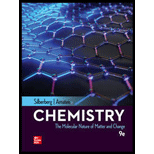
(a)
Interpretation:
The name and formula of the compound formed from
Concept introduction:
In the periodic table, the elements are represented using alphabetic symbols. Each element has a unique symbol which distinguishes it from other elements. The atomic
Ionic compounds are those which are made of ions. Ions are charged particles produced when atoms gain or lose electrons. It is typically formed when a metal at the extreme left of the periodic table reacts with a non-metal at the extreme right of the table.
(b)
Interpretation:
The name and formula of the compound formed from
Concept introduction:
In the periodic table, the elements are represented using alphabetic symbols. Each element has a unique symbol which distinguishes it from other elements. The atomic symbols of the elements are derived from their English, Latin or Greek names. The subscript in the
Ionic compounds are those which are made of ions. Ions are charged particles produced when atoms gain or lose electrons. It is typically formed when a metal at the extreme left of the periodic table reacts with a non-metal at the extreme right of the table.
(c)
Interpretation:
The name and formula of the compound formed from
Concept introduction:
In the periodic table, the elements are represented using alphabetic symbols. Each element has a unique symbol which distinguishes it from other elements. The atomic symbols of the elements are derived from their English, Latin or Greek names. The subscript in the
Ionic compounds are those which are made of ions. Ions are charged particles produced when atoms gain or lose electrons. It is typically formed when a metal at the extreme left of the periodic table reacts with a non-metal at the extreme right of the table.
Want to see the full answer?
Check out a sample textbook solution
Chapter 2 Solutions
Chemistry: The Molecular Nature of Matter and Change
- i need help identifying the four carbon oxygen bonds in the following:arrow_forwardImagine each of the molecules shown below was found in an aqueous solution. Can you tell whether the solution is acidic, basic, or neutral? molecule HO H3N + The solution is... X O acidic OH O basic H3N-CH-C-O O neutral ○ (unknown) O acidic ○ basic CH2 CH 3-S-CH2 O neutral ○ (unknown) H3N O OH O acidic O basic Oneutral O (unknown) 0 H3N-CH-C-O CH3 CH CH3 O acidic O basic O neutral ○ (unknown) ? olo Ar BHarrow_forwardno Ai walkthroughs need other product (product in picture is wrong dont submit the same thing)arrow_forward
- I have a 2 mil plastic film that degrades after 22 days at 88C and at 61C takes 153 days. What is the failure at 47C in days.arrow_forwardIf a 5 film plastic film degraded in 30 days at 35C and the same film degraded in 10 days at 55 C and 2 days at 65C what would the predicted life time be at 22C for the same film?arrow_forwardno Ai walkthroughsarrow_forward
- I have a aqueous solution (175 ml) of iridium trichloride containing 8,750 ppm Iridium by ICP OES analysis. What is the percent concentration of Iridium trichloride in aquous solution and provide the concentration in moles per liter, percentage by weight.arrow_forwardno Ai walkthroughsarrow_forwardno Ai walkthroughsarrow_forward
 ChemistryChemistryISBN:9781305957404Author:Steven S. Zumdahl, Susan A. Zumdahl, Donald J. DeCostePublisher:Cengage Learning
ChemistryChemistryISBN:9781305957404Author:Steven S. Zumdahl, Susan A. Zumdahl, Donald J. DeCostePublisher:Cengage Learning ChemistryChemistryISBN:9781259911156Author:Raymond Chang Dr., Jason Overby ProfessorPublisher:McGraw-Hill Education
ChemistryChemistryISBN:9781259911156Author:Raymond Chang Dr., Jason Overby ProfessorPublisher:McGraw-Hill Education Principles of Instrumental AnalysisChemistryISBN:9781305577213Author:Douglas A. Skoog, F. James Holler, Stanley R. CrouchPublisher:Cengage Learning
Principles of Instrumental AnalysisChemistryISBN:9781305577213Author:Douglas A. Skoog, F. James Holler, Stanley R. CrouchPublisher:Cengage Learning Organic ChemistryChemistryISBN:9780078021558Author:Janice Gorzynski Smith Dr.Publisher:McGraw-Hill Education
Organic ChemistryChemistryISBN:9780078021558Author:Janice Gorzynski Smith Dr.Publisher:McGraw-Hill Education Chemistry: Principles and ReactionsChemistryISBN:9781305079373Author:William L. Masterton, Cecile N. HurleyPublisher:Cengage Learning
Chemistry: Principles and ReactionsChemistryISBN:9781305079373Author:William L. Masterton, Cecile N. HurleyPublisher:Cengage Learning Elementary Principles of Chemical Processes, Bind...ChemistryISBN:9781118431221Author:Richard M. Felder, Ronald W. Rousseau, Lisa G. BullardPublisher:WILEY
Elementary Principles of Chemical Processes, Bind...ChemistryISBN:9781118431221Author:Richard M. Felder, Ronald W. Rousseau, Lisa G. BullardPublisher:WILEY





